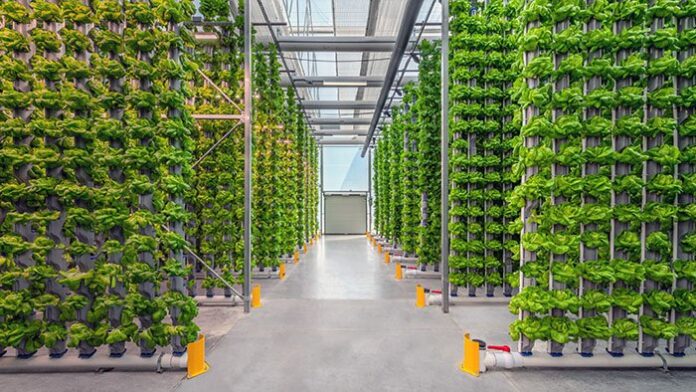Vertical Farming and Indoor Agriculture : A Transformative Approach Towards Revolutionizing Livestock Production
[Abstract]
In the ever-evolving landscape of agriculture, traditional methods are giving way to innovative solutions aimed at meeting the growing demand for food while minimizing environmental impact. One such groundbreaking approach is vertical farming and indoor agriculture, which is revolutionizing livestock production as we know it. Livestock production is a cornerstone of global agriculture, providing essential resources such as meat, dairy, and eggs. However, traditional methods of raising livestock face numerous challenges, including land and water scarcity, environmental degradation, and concerns about animal welfare. In response to these challenges, vertical farming and indoor agriculture have emerged as innovative solutions that offer significant advantages in terms of efficiency, sustainability, and animal welfare. This article explores how these technologies are revolutionizing livestock production and shaping the future of agriculture.
Vertical farming involves the cultivation of crops and even the raising of livestock in vertically stacked layers, often in controlled indoor environments. This method utilizes advanced technologies such as hydroponics, aeroponics, and aquaponics to provide optimal growing conditions without relying on traditional soil-based farming. By maximizing space and resources, vertical farming offers unparalleled efficiency and sustainability. In the realm of livestock production, vertical farming presents a paradigm shift from conventional practices. Traditionally, raising livestock requires vast amounts of land, water, and feed, contributing to deforestation, water depletion, and greenhouse gas emissions. However, vertical farming challenges this status quo by offering a compact, resource-efficient alternative.
Advantages of Vertical Farming and Indoor Agriculture in Livestock Production:
- Land Efficiency:
Vertical farming and indoor agriculture require significantly less land compared to traditional farming methods, making them ideal for urban areas and regions with limited arable land.By utilizing vertical space, these systems can produce high yields in a small footprint, reducing the pressure on natural ecosystems and preserving valuable land for other purposes.
- Water Conservation:
Indoor agriculture systems typically use recirculating water systems, minimizing water usage compared to conventional farming.
- Animal Welfare:
Indoor environments offer opportunities to optimize animal welfare conditions, including temperature control, lighting schedules, and disease prevention measures. Livestock housed in vertical farms or indoor facilities are protected from predators, reducing stress and improving overall well-being.
The integration of technology plays a crucial role in the success of vertical farming for livestock production. Advanced sensors, robotics, and artificial intelligence monitor and manage every aspect of the farming process, from feeding and watering to waste management and disease detection. This high level of automation not only increases efficiency but also reduces the need for manual labor, making vertical farming a viable solution for the future of agriculture.
Moreover, vertical farming offers resilience against external factors such as climate change and natural disasters. By operating indoors, farmers can shield their livestock from extreme weather events, pests, and diseases, ensuring a consistent supply of food regardless of external conditions. This reliability is essential for meeting the demands of a growing global population while mitigating the risks associated with traditional farming methods.
Companies like Plenty and AeroFarms are exploring the use of vertical farming to produce nutritious fodder for livestock, reducing the environmental impact of feed production and improving animal nutrition.
Challenges and Future Directions:
- Despite the numerous advantages of vertical farming and indoor agriculture, challenges remain, including high initial investment costs, energy consumption, and technological limitations.
- Continued research and development efforts are needed to improve efficiency, reduce costs, and scale up these technologies to meet the growing demand for sustainable livestock production.
- Collaboration between stakeholders, including farmers, researchers, policymakers, and investors, is essential to overcome barriers and unlock the full potential of vertical farming and indoor agriculture.
In conclusion, vertical farming and indoor agriculture represent a transformative approach to livestock production, offering sustainable, efficient, and resilient solutions to the challenges facing modern agriculture. By harnessing the power of technology and innovation, farmers can revolutionize the way we raise livestock, ensuring food security for generations to come. As we continue to embrace these advancements, the future of agriculture looks brighter than ever before and investing in vertical farming and indoor agriculture will be crucial for building a resilient and sustainable food system that can meet the needs of a growing global population.
Submitted by : Gunjan Deka, 2021-VL-53
Lakhimpur College of Veterinary Science, Joyhing, North Lakhimpur
Acknowledgement :
I want to express my gratitude to Dr. Biju Borah, PhD, Assistant Professor, Department of Veterinary & Animal Husbandry Extension Education, Lakhimpur College of Veterinary Science, for giving me the opportunity to learn, gain knowledge and write an article on the above mentioned topic.
References :
http://https://www.edengreen.com/blog-collection/what-is-vertical-farming



